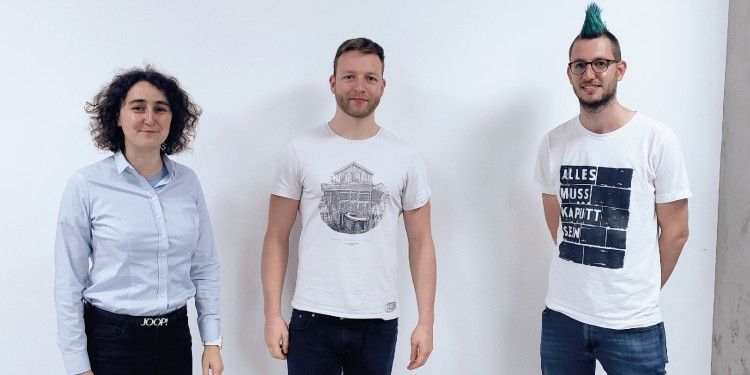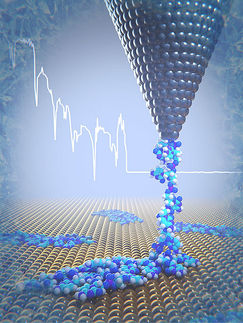Switching DNA functions on and off by means of light
Biochemists use protein engineering to transfer photocaging groups to DNA
DNA (deoxyribonucleic acid) is the basis of life on earth. The function of DNA is to store all the genetic information, which an organism needs to develop, function and reproduce. It is essentially a biological instruction manual found in every cell. Biochemists at the University of Münster have now developed a strategy for controlling the biological functions of DNA with the aid of light. This enables researchers to better understand and control the different processes which take place in the cell – for example epigenetics, the key chemical change and regulatory lever in DNA.

Happy about the publication: Prof. Andrea Rentmeister, Nils Klöcker and Nicolas Cornelissen (from left).
© AG Rentmeister
Background and methodology
The cell’s functions depend on special molecules, the enzymes. Enzymes are proteins, which carry out chemical reactions in the cell. They help to synthesize metabolic products, make copies of the DNA molecules, convert energy for the cell’s activities, change DNA epigenetically and break down certain molecules. A team of researchers headed by Prof. Andrea Rentmeister from the Institute of Biochemistry at the University of Münster used a so-called enzymatic cascade reaction in order to understand and track these functions better. This sequence of successive reaction steps involving different enzymesmakes it possible to transfer so-called photocaging groups – chemical groups, which can be removed by means of irradiation with light – to DNA. Previously, studies had shown that only small residues (small modifications such as methyl groups) could be transferred very selectively to DNA, RNA (ribonucleic acid) or proteins. “As a result of our work, it is now possible to transfer larger residues or modifications such as the photocaging groups just mentioned,” explains Nils Klöcker, one of the lead authors of the study and a PhD student at the Institute of Biochemistry. Working together with structural biologist Prof. Daniel Kümmel, who also works at the Institute of Biochemistry, it was also possible to explain the basis for the changed activity at a molecular level.
Using so-called protein engineering – a method for which a Nobel prize was awarded in 2018 – the Münster researchers engineered one enzyme in the cascade, making it possible to switch DNA functions on and off by means of light. With the aid of protein design, it was possible to expand the substrate spectrum of enzymes – in this case, methionine adenosyltransferases (MATs). In their work, the researchers examined two MATs. The modifications carried out offer a starting point for developing other MATs with an expanded substrate spectrum. “Combining these MATs with other enzymes has potential for future cellular applications. This is an important step for implementing in-situ generated, non-natural substances for other enzymes in epigenetic studies,” says Andrea Rentmeister.
Original publication
Freideriki Michailidou, Nils Klöcker, Nicolas Cornelissen, Rohit K. Singh, Aileen Peters, Anna Ovcharenko, Daniel Kümmel, Andrea Rentmeister; "Engineered SAM synthetases for enzymatic generation of AdoMet analogs with photocaging groups and reversible DNA modification in cascade reactions"; Angewandte Chemie Int. Ed.; 2020
Most read news
Original publication
Freideriki Michailidou, Nils Klöcker, Nicolas Cornelissen, Rohit K. Singh, Aileen Peters, Anna Ovcharenko, Daniel Kümmel, Andrea Rentmeister; "Engineered SAM synthetases for enzymatic generation of AdoMet analogs with photocaging groups and reversible DNA modification in cascade reactions"; Angewandte Chemie Int. Ed.; 2020
Organizations
Other news from the department science

Get the life science industry in your inbox
By submitting this form you agree that LUMITOS AG will send you the newsletter(s) selected above by email. Your data will not be passed on to third parties. Your data will be stored and processed in accordance with our data protection regulations. LUMITOS may contact you by email for the purpose of advertising or market and opinion surveys. You can revoke your consent at any time without giving reasons to LUMITOS AG, Ernst-Augustin-Str. 2, 12489 Berlin, Germany or by e-mail at revoke@lumitos.com with effect for the future. In addition, each email contains a link to unsubscribe from the corresponding newsletter.
More news from our other portals
Last viewed contents
Water_net
Skin-like tissue developed from human embryonic stem cells
ProBioGen Signed Agreement on Testing of Neuronal Cell Lines with Serono
Ovulitis_azaleae
N-Formylmethionine_(data_page)
Valgus_deformity
Mind_uploading
Striped_Cuckoo



















































